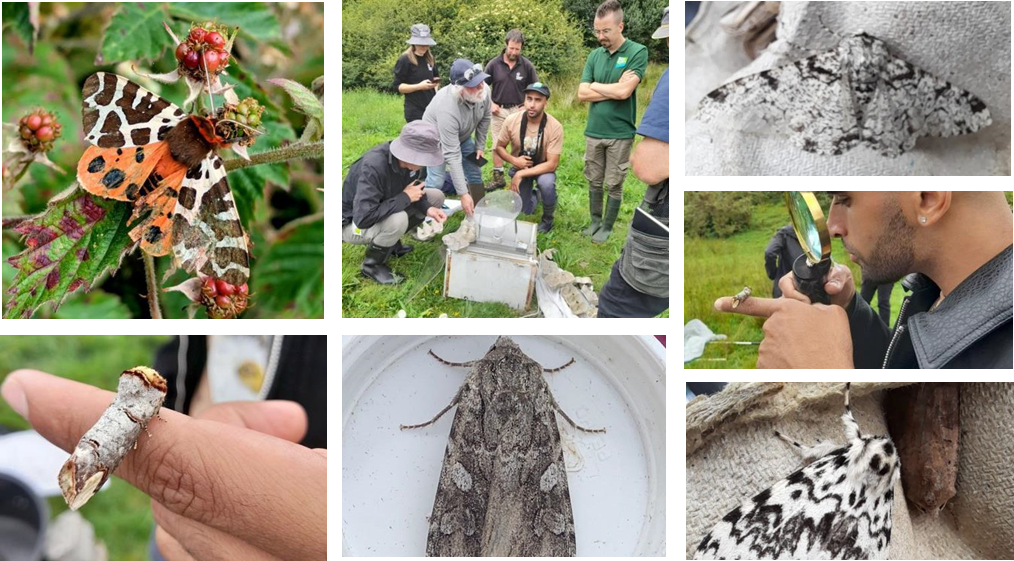Fourteen experts, fen managers, volunteers and enthusiasts joined us to look at what invertebrates we could find using different sampling techniques on the fens at Cors Castell on Ynys Môn. Cors Castell is an area of Cors Goch that is less commonly surveyed, so the records will be invaluable to guide conservation actions. The small area surveyed contained a mix of trees, meadow and calcareous fen wetland habitat that support a wide range of species.
Light trapping for Magnificant Moths (Figure 1)
The night of 25th July was warm, still and overcast, which was perfect for moth trapping. Our local moth experts, Charles Aron and Steve Palin set up 3 light traps and the day started with opening them up and seeing what had been caught. There were a staggering 1009 individual moths from 125 different species in the traps.
The stand-out species from the day was the Great Brocade (Eurois occulta) whose caterpillars feed on Bog Myrtle. Its status is Nationally Scarce B; just 4 modern-day records exist from Anglesey, all in 2006. Apart from being a large, spectacular moth, it’s interesting in being a scarce immigrant from northern
Europe, although it does breed in the Scottish Highlands.
The mobility, adaptability and life histories of moths makes them good candidates for observing the impact of climate change on species and their distribution. The Garden Tiger (Arctia caja) prefers a cool, wet climate and has declined by >90% across Britain (Hordley et al., 2025). Its wings are mottled white, brown, orange and blue, and no two individuals are exactly the same. In contrast, species such as the Dingy Footman (Eilema griseola) and Black Arches (Lymantria monacha) prefer warmer weather and are spreading Northwards as a result of global warming.
Moths make a tasty meal for a variety of bird species, and they have evolved over time to blend into their environment to avoid getting predated. It was good to see the pale version of the Peppered Moth (Biston betularia) which is an indicator of the clean air on Ynys Môn. Darker forms evolved in West Yorkshire,
associated with pollution from the coal industry. Spectacular camouflage was displayed by the Buff Tip (Phalera bucephala), which is an almost exact replica of a silver birch twig. This was one of six species of Prominent moths found. Once we had admired the moths, they were all carefully released back into the vegetation where they seamlessly moved behind twigs and leaves to avoid being eaten.

Figure 1. (Clockwise from top left) Garden Tiger (Arctia caja) © David Barwani-Rai, Opening the light trap, Peppered Moth (Biston betularia), Close inspection, Black Arches (Lymantria monacha), Great Brocade (Eurois occulta) ©Charles Aron, Buff Tip (Phalera Bucephala)
Observing Yellow and Black Insects (Figure 2)
On the fields surrounding the fen, the group looked carefully at flowering hogweed plants, searching for the rare Clubbed General Soldierfly (Stratiomys chamaeleon). The larvae of this species are semi-aquatic and confined to a few open, calcareous fens on Ynys Môn in Wales. This species is at risk due to the drying out of the fens and availability of their Umbellifer host plants for adults to nectar on. Yellow and black are universal warning colours, indicating poison and stinging found in some bees and wasps. Other species
adapt to these colours in order to deter predators, and it was fascinating to see how many yellow and black insects were seen on flowers from different orders of insects, including a single male S. chamaeleon. Only one of the species shown stings. If you look carefully, you can see the body shapes of species from
different orders are quite distinct and note how they all hold their wings differently. Observing these features, as well as the length and shape of the antennae, is a good start towards identifying these species that look similar at first glance.

Figure 2. A few examples of black and yellow insects we found at Cors Castell (clockwise from top left): Syrphus ribesii (Hoverfly), Stratiomys chamaeleon (Clubbed General Soldierfly), Tethredo sp. (Sawfly), Sesia bembeciformis (Lunar Hornet Moth) ©Steve Palin, Vespula vulgaris (Common Wasp)
Vacuum sampling and sweep netting (Figure 3)
In the wetter part of the fen, spider expert Richard Gallon led on the search for the Nationally Rare Sedge Jumper spiders (Attulus caricis). Using a vacuum sampler, eight individuals were found inhabiting Black Bog-rush tussocks. There are only seven known populations of this attractive fenland spider in Wales, and four of these are on Ynys Môn. Another rare species found in this wet area was the leafhopper Cicadella
lasiocarpae that feeds on slender sledge. It was interesting to note that this species was more abundant in the most recently cut fen, where the growth was less woody. I don’t know which of these species jumps the furthest, but they were certainly jumping all over the place, to the great excitement of participants.

Figure 3 (Clockwise from top left) Examining a beating tray, Richard Gallon suction sampling, Attulus caricis ©Liam Olds, Cicadella lasiocarpae ©Liam Olds, Biggest catch of the day!?
Acknowledgments
Many thanks to Chris Wynne and North West Wildlife Trust colleagues for hosting the survey, to Charles Aron and Steve Palin for counting and identifying 1009 moths, to Richard Gallon for vacuum sampling and spider knowledge, to Mike Howe for sharing his local species knowledge, to Liam Olds who came on his birthday and to all enthusiastic participants who made it a grand day out. Photos © Clare Sampson unless otherwise stated.
Special thanks to the funders of the Natur am Byth! Project, The National Lottery Heritage Fund, Esmée Fairburn and Landfill Disposals Tax Communities Scheme for making such days possible. This type of funding aids recovery of the rarest species in our local environment and promotes a greater understanding of the fabulous natural resources around us.